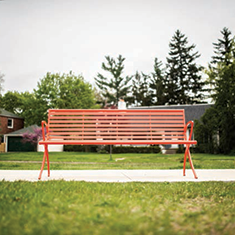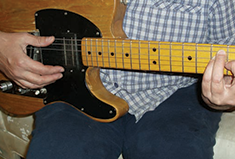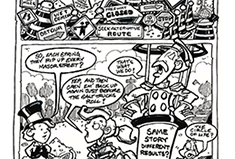Walkable Ferndale, Walkable Life
By Rebecca Hammond
DETROIT IS A FRIENDLY CITY AND FERNDALE MIGHT BE ITS FRIENDLIEST SUBURB. IT’S RARE TO GO FOR A STROLL AND HAVE ANOTHER WALKER NOT RETURN A HELLO.
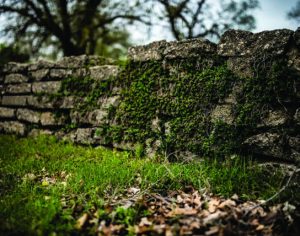 We see lots of walkers-by from our front porch, sometimes folks we’ve never seen before, but usually the same people day after day, reliable enough that it can be worrisome to not see someone for a few days. Everyone who passes says hi, and even people across the street wave and call out. The typical small talk is what seems to make the world go round. The weather, their dog, which flowers are in bloom at the moment, and isn’t that garden a lot of work compared to a lawn (no, it’s much less). The encounters never get old.
We see lots of walkers-by from our front porch, sometimes folks we’ve never seen before, but usually the same people day after day, reliable enough that it can be worrisome to not see someone for a few days. Everyone who passes says hi, and even people across the street wave and call out. The typical small talk is what seems to make the world go round. The weather, their dog, which flowers are in bloom at the moment, and isn’t that garden a lot of work compared to a lawn (no, it’s much less). The encounters never get old.
We’re a known walkable city thanks to ongoing efforts by multiple officials and maybe some lucky geography, with even those of us living at the outer edges of our four quadrants being a comfortable stroll to and from our thriving downtown. We can walk to do anything here and, although I don’t know many who live completely car-free, it’s possible. Phil just left the house for his almost-daily walk to the Library (and Western Market on the way home). We’ve walked to Hambo for years once a week to meet neighbors for breakfast, usually hitting Credit Union One, the Library, and either Natural Food Patch or New York Bagel before heading home.
Ace Hardware in Oak Park is walkable for lots of us. So are two bookstores, Library Books on 9 Mile, and King Books on Woodward, and countless places to eat and drink. Howe’s Bayou is a favorite on-foot destination. So is Anita’s Kitchen. Last week I walked to Mezcal for lunch with two beloved friends. If you want service as friendly as encounters on Ferndale’s sidewalks are, with terrific food as a bonus, head to Mezcal. On the way, birdwatch. And garden gaze. I’ll bet in a month or so it’ll be impossible to find a block in Ferndale without one front yard boasting milkweed.
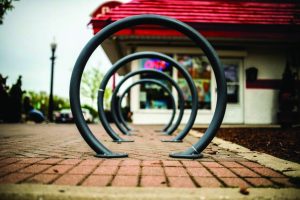 WALKING IS WAY OF LIFE in rural Michigan, too. Last fall Phil and I spent two days biking from Rogers City to Cheboygan and back, and met two old guys (“older” meaning about our age) who each walked five miles a day. Neither said why, but both gave the impression that a health crisis had precipitated a big turnaround, a change in lifestyle by someone determined to not only stay alive, but thrive.
WALKING IS WAY OF LIFE in rural Michigan, too. Last fall Phil and I spent two days biking from Rogers City to Cheboygan and back, and met two old guys (“older” meaning about our age) who each walked five miles a day. Neither said why, but both gave the impression that a health crisis had precipitated a big turnaround, a change in lifestyle by someone determined to not only stay alive, but thrive.
Many long-distance hiking books include a personal transformation, so much so that those of us who read them would be disappointed if Cheryl Strayed had not found release from her grief and a self-destructive life in Wild, or Heather Anderson hadn’t found a way to cope with self-doubt in Mud, Rocks, Blazes, her Appalachian Trail story. My copy of Granny D, bought for a dollar at the Ferndale library, is signed by author Doris Haddock, to Ferndale’s own Nancy Goedert. Like Strayed, Haddock walked a long distance, finally finding release from the grief of two great losses. She made it from coast-to-coast, to bring attention to the need for campaign finance reform. At age 89 she found herself in much better health after her years on the road than before it.
Raynor Winn’s marvelous The Salt Path, though, tells of another health transformation. After losing their farm to a long-time friend’s treachery, she and husband Moth set out on the Coastal Path in SW Britain, mainly because they had no money to do anything else, including buy or rent another home. Did I mention that Moth had also just been given a terminal diagnosis, in the same week they lost their farm? His doctor warned him to take it easy, not exert himself, and to expect the rest of his life to last two years. What they found to their surprise was that as the weeks passed, Moth got better and stronger. Winn’s second book, The Deep Silence, is partly about her research into why this was probably so. Like the two Michigan guys we met along US23 on the shores of Lake Huron, walking was curative, more than expected or hoped for.
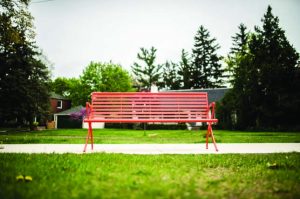 A FAVORITE TOPIC ON SOCIAL-MEDIA HIKING PAGES IS FOOTWEAR. People often insist that only hiking boots will do, but walkers here wear everything. I hate boots even on the trail. It feels like a bucket on each foot. After years of my own trial and error (and discovering the YouTube channel Homemade Wanderlust and its charm- ing host Dixie) I’ve settled on on Altra trail runners. But, like lots of the people going past our porch constantly, I’ve tried sports sandals, flip- flops, even going barefoot.
A FAVORITE TOPIC ON SOCIAL-MEDIA HIKING PAGES IS FOOTWEAR. People often insist that only hiking boots will do, but walkers here wear everything. I hate boots even on the trail. It feels like a bucket on each foot. After years of my own trial and error (and discovering the YouTube channel Homemade Wanderlust and its charm- ing host Dixie) I’ve settled on on Altra trail runners. But, like lots of the people going past our porch constantly, I’ve tried sports sandals, flip- flops, even going barefoot.
Michigan, in fact, used to have a barefoot hiking club which was featured on the front page of the Free Press’ Sunday Life section long ago; a few states still have them. Humans used to walk lon- ger distances with more basic footwear. Maybe we’ve gotten overly worried about ankle and arch support. Everyone has to figure out what works for them. The best shoe doesn’t remind you it’s on your foot. Emma Gatewood of Ohio hiked the Appalachian Trail three times, the first at age 67, wearing Converse tennies or Keds. Books on hiking, like former US Representative David Bonior’s Walking to Mackinac, are books with blisters being a prominent sub-topic, if like Bonior and his wife Judy, the writer/hiker wore boots. Wild is also a book with a boots-and-blisters subplot.
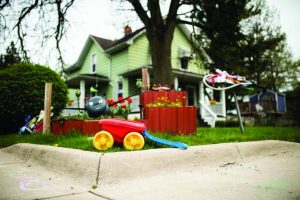 Many of us are using our devices to track a daily goal of 10,000 steps. Being a person who’s not so much allergic to technology as finding it allergic to me, I’m still surprised that after years of having no cell phone, then a lowly flip phone, I’m enjoying my iPhone mainly because of that health app and its step-counting. It’s a good feeling to go on an errand and glance at the phone when you get home and discover you’re two-thirds of the way to 10,000. Get out and walk! Ferndale is the perfect place for it.
Many of us are using our devices to track a daily goal of 10,000 steps. Being a person who’s not so much allergic to technology as finding it allergic to me, I’m still surprised that after years of having no cell phone, then a lowly flip phone, I’m enjoying my iPhone mainly because of that health app and its step-counting. It’s a good feeling to go on an errand and glance at the phone when you get home and discover you’re two-thirds of the way to 10,000. Get out and walk! Ferndale is the perfect place for it.

